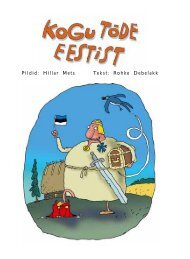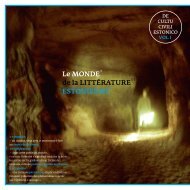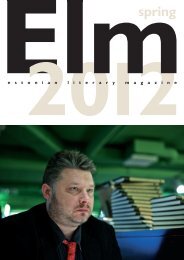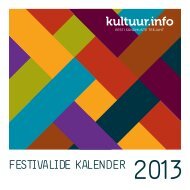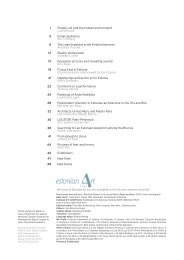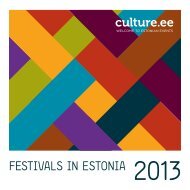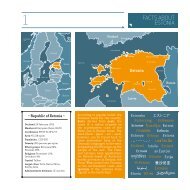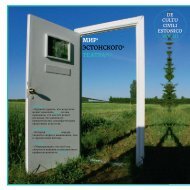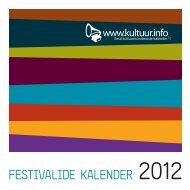Autumn 2013
Autumn 2013
Autumn 2013
You also want an ePaper? Increase the reach of your titles
YUMPU automatically turns print PDFs into web optimized ePapers that Google loves.
flat with a veranda, where they always employed<br />
a servant as well. He published nine novels,<br />
two plays, quite a few short stories and<br />
over 300 articles. Tammsaare was also a<br />
prolific translator, knowing six foreign languages<br />
(English, German, Russian, French, Finnish<br />
and Swedish). Among his translations were<br />
significant literary works, such as Oscar<br />
Wilde’s The Picture of Dorian Gray, Dostoyevsky’s<br />
Crime and Punishment, Knut Hamsun’s<br />
Victoria and T. E. Lawrence’s Seven Pillars of<br />
Wisdom.<br />
The writer’s unexpected death on 1 March<br />
1940 was a national day of mourning, and<br />
thousands of people turned out for his funeral.<br />
A few months later, the Soviet army marched<br />
into Estonia and thus Tammsaare’s funeral<br />
also constituted the funeral of the entire free<br />
Estonian republic.<br />
After Estonia was forced into the Soviet<br />
Union, Tammsaare’s work was temporarily<br />
included on the list of suspicious books. The<br />
writer’s critical attitude towards proletarian<br />
revolution and his multi-layered life philosophy<br />
caused many headaches for the censors. In<br />
1950, a solution was found: the Marxist interpretation<br />
allowed people to continue reading<br />
and researching Tammsaare, although only in<br />
line with official ideology. Nevertheless, his<br />
works were like a fresh breeze from pre-war<br />
Estonia, and people found great consolation<br />
in them.<br />
As Tammsaare’s life and work offer a<br />
wealth of material, he finally became one of<br />
the most researched Estonian writers during<br />
the Soviet era. This was essential in terms of<br />
both Tammsaare studies and maintaining our<br />
cultural traditions. Quite a few of the acclaimed<br />
pre-war novelists – for example August Gailit<br />
– were largely ignored. Some of the works of<br />
Gailit, who escaped abroad, were in fact<br />
banned in Estonia and disappeared from the<br />
consciousness of many readers.<br />
The Soviet-era interpretation of Tammsaare<br />
created, for several generations, an<br />
understanding of the writer as a great critical<br />
realist. This was almost the only possible way<br />
to talk about him. This “correct reading model”<br />
had to be vigorously rectified after Estonia<br />
became independent again in 1992. Tammsaare’s<br />
work was taken up by a new wave<br />
of researchers at the turn of the millennium,<br />
when various myths were overturned, e.g.<br />
about Tammsaare as an atheist writer (see<br />
research by Toomas Liiv and others about the<br />
writer and the Bible/theology).<br />
When I started work in 2002 at the A. H.<br />
Tammsaare Museum in Tallinn, I encountered<br />
the attitude (and still do) that Tammsaare<br />
was boring, because he was mainly seen as<br />
a critical realist. This attitude encouraged me<br />
to compile collections of articles about the<br />
writer’s essays in 2010 and 2011, and write<br />
my doctoral thesis, Poetics of irrationality in<br />
A.H.Tammsaare’s work (2011), in order to<br />
point out other levels in the writer’s work. In<br />
2011, another doctoral thesis was defended:<br />
Mirjam Hinrikus’s The experience of<br />
decadent modernity in the texts of A. H.<br />
Tammsaare and Young-Estonia. In the<br />
spring of this year a number of acclaimed<br />
literary scholars published a collection of<br />
articles on Tammsaare’s novel I Loved a<br />
German; Tammsaare’s work continues to<br />
inspire BA and MA papers.<br />
There is thus no reason to complain about<br />
a lack of research on Tammsaare. There are<br />
not many writers in Estonia who are analysed<br />
in doctoral theses, in collections of articles devoted<br />
to one particular work, or even in individual<br />
articles and references. Scholarly discussion<br />
of Tammsaare’s work shows no signs of<br />
abating. In November the Museum will organise<br />
yet another autumn conference, this time<br />
focusing on characters in the writer’s work in<br />
comparison with characters created by other<br />
authors. Besides Estonians, papers will be presented<br />
by researchers from Finland and France.<br />
Why France? In the rather impressive body<br />
of Tammsaare translations (his works have<br />
been translated into about 30 languages),<br />
French translations have a special place. In<br />
the 1930s, the five-volume Truth and Justice<br />
was quickly translated into German and in the<br />
1940s, via German, into French. Surprisingly,<br />
the reception amongst readers was more<br />
enthusiastic in France than it was in Germany.<br />
The French writer Jean Gino wrote an intro-



